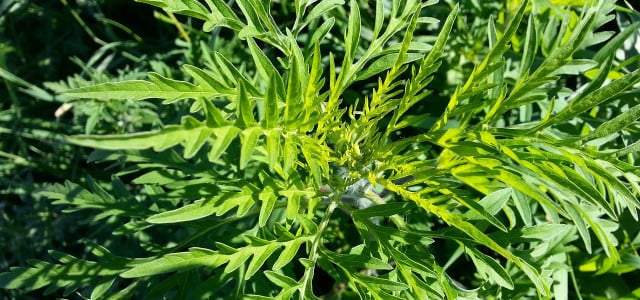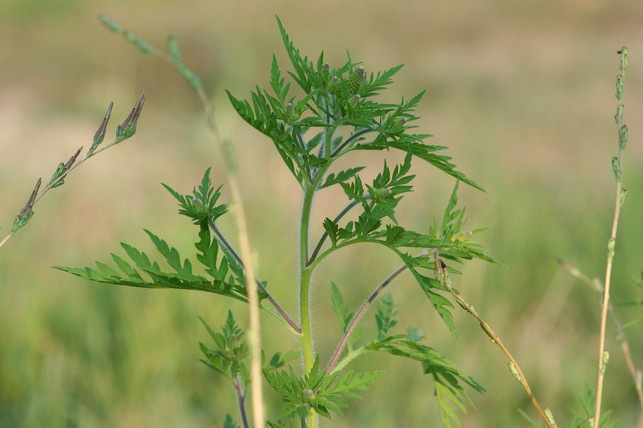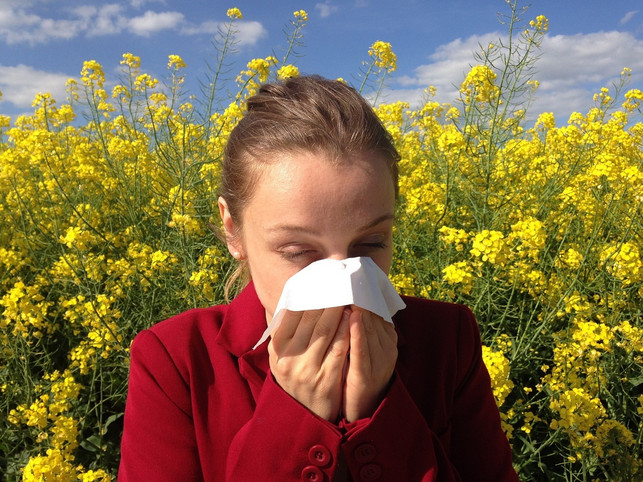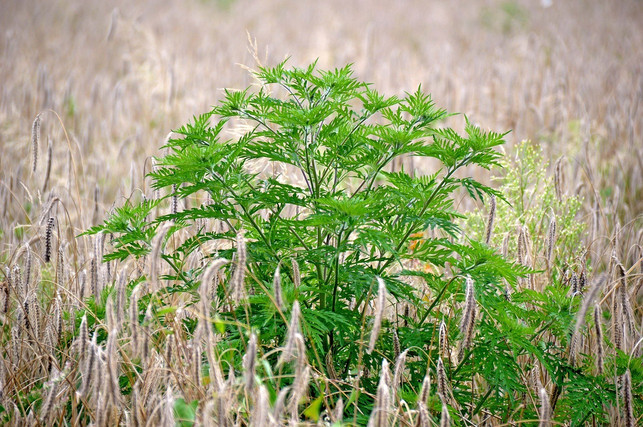
A ragweed allergy can feel like severe hay fever – or cause more severe symptoms. You can find out why the plant is so dangerous and how to treat the allergy symptoms here.
Ambrosia, also called ragweed or ragweed (Ambrosia artemisiifolia), is a plant from the daisy family. It originally comes from North America and was imported to Europe in the 19th century. Since then it has spread rapidly. In addition to the changing climate, this is primarily due to bird food and seed mixtures that are contaminated with ragweed seeds.
In Germany, ragweed has so far spread primarily in Berlin and the south of Brandenburg, but the population is also increasing in southern Germany and more people are becoming allergic to ragweed. Most plants grow unnoticed on fallow land, traffic islands, on the side of the road or as weeds on arable land. The plant blooms in July and August.
Incidentally, common mugwort is visually very similar to ragweed. Many people also react allergically to this composite plant (also read: Mugwort allergy: symptoms and effective home remedies).
Ambrosia allergy: This is why the plant is so dangerous

(Photo: CC0 / Pixabay / jofoto)
Ambrosia poses great dangers because the plants can cause severe allergies and their spread poses an ever-increasing health risk. This is due to the following reasons:
- A density of around ten ragweed pollen per cubic meter of air is enough to cause allergic reactions.
- A single ragweed plant contains a billion pollen. The seeds are very stubborn and remain viable for several decades. It is therefore almost impossible to completely prevent their spread.
- People who already suffer from a pollen allergy are also at risk of a ragweed allergy. The plant can even cause allergic asthma. This is still relatively rare in Germany – but that could change in the next few decades.
Symptoms of ragweed allergy

(Photo: CC0 / Pixabay / cenczi)
When coming into contact with ragweed pollen, the usual symptoms of a pollen allergy usually occur in an increased form. Because the pollen is very small, it can reach deep into the bronchi. There they often cause asthma attacks.
When your body comes into contact with ragweed pollen for the first time, sensitization may occur. This means that the next time you come into contact with the pollen you will develop the typical symptoms of a ragweed allergy:
- frequent and repeated sneezing
- Nose itching
- Itchy palate
- a stuffy or runny nose
- difficult breathing through the nose
- watery, burning and itching eyes
- Asthma attacks, which manifest themselves as a dry cough, difficulty breathing and shortness of breath
- Red, itchy areas of skin and skin eczema upon skin contact with the leaves and stems of the plant
Bad news for pollen allergy sufferers: Ambrosia has a long flowering period – as already mentioned, this lasts from July to October. The long pollen count is due to the fact that the plant spreads so widely.
A 2015 study also showed that ragweed pollen appears even more aggressive if it has previously been exposed to exhaust fumes. Since ragweed plants often grow on roadsides and highways, this can make allergic reactions even worse.
Treat ragweed allergy

(Photo: CC0 / Pixabay / Ralphs_Fotos)
There are no specific remedies for ragweed allergy. To combat and prevent the symptoms, you can use the following home remedies for hay fever:
- The best way to combat an itchy nose is to use a steam bath, which moistens and cleanses the nasal mucous membranes.
- If you have burning or irritated eyes, you can use a decoction of eyebright. Used as an eye mask or nasal rinse, the medicinal herb can alleviate the symptoms.
- Install a pollen screen on your windows to keep pollen out of your house, car and apartment.
In addition, there are some medications such as antihistamines, anti-allergic eye drops and decongestant nasal spray. You can usually get these without a prescription from the pharmacy. However, we advise you to seek medical advice before taking the medication. If ragweed pollen causes you severe asthma, you can have an asthma spray prescribed.
However, these remedies cannot cure your allergy. This is what immunotherapy is for (so-called hyposensitization). With this therapy, your immune system gets used to contact with the allergen over a longer period of time. Please discuss such a step with your family doctor.
Prevent ragweed allergy

(Photo: CC0 / Pixabay / Katja_Kolumna)
The most effective way to prevent allergy symptoms is to prevent ragweed from spreading further. You have the following options:
-
Recognize: The plant grows up to 130 centimeters and looks similar to mugwort: It has pinnate leaves and elongated inflorescences. You can recognize ragweed by its often reddish, hairy stems.
-
Garden: If you discover ragweed plants in your garden, you should carefully remove them along with the entire root system and dispose of them in the trash. Under no circumstances should you throw it into the organic waste or compost – it will only sprout again. It’s best to wear gloves.
-
City: If you notice ragweed in the city area, you can report the occurrence to the parks department or plant protection office. In some communities, authorities are committed to combating ragweed on a large scale – for example in Berlin.
Read more on Techzle\.com:
- Allergy medications in the test: Which medications help with pollen count?
- Pollen calendar 2019: The most important grasses at a glance
- Soy allergy: How to recognize and avoid soy products
Edited by Lea Hermann
** marked with ** or orange underlined Links to sources of supply are partly partner links: If you buy here, you are actively supporting Techzle\.com, because we then receive a small part of the sales proceeds. More info.